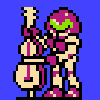Xenophobe (Arcade) review"In 1987 Bally Midway engineered Xenophobe, a one-to-three person alien extermination effort with a twist. While simultaneous cooperative play has roots far deeper in gaming history, perhaps never before had a developer so intuitively envisioned the future of multiplayer. Xenophobe divides a single arcade monitor into three strips of screen, each player entitled his own. Each strip initially displays a chamber of an extraterrestrially overrun environment, all of the settings sli..." |
In 1987 Bally Midway engineered Xenophobe, a one-to-three person alien extermination effort with a twist. While simultaneous cooperative play has roots far deeper in gaming history, perhaps never before had a developer so intuitively envisioned the future of multiplayer. Xenophobe divides a single arcade monitor into three strips of screen, each player entitled his own. Each strip initially displays a chamber of an extraterrestrially overrun environment, all of the settings slightly different in theme while caught under the same generic term "alien base" (not stale, per se, but lacking variety). Players can see and interact with each other on each strip, yet one player moving left and right into a different room will not affect other players, with only one of the three displays shifting. In this way Xenophobe allows for cooperative play, minor strategy in assigning routes, exploratory ventures ("you go on ahead," directed at the healthiest comrade) and zero reason even a novice can't join mid-game and be of assistance. At a time when most side-scrolling titles chewed the left side of the screen, Xenophobe excels by lifting restrictions that made joint exploration impossible while still remaining undoubtedly action oriented.
Levels are completed when a base stands fully exterminated or a timer expires, the former being especially hard for the single player to accomplish, yet thankfully will not cost lives or impede progress. Staying alive is key; each quarter buys the player health, and initially armed with the phazer pistol he’s beamed aboard a hostile enemy environment. Left and right are the two preliminary options, but there are shortcuts to different floors, items and keycards to collect to set detonators, combat predators and seal passageways and a heaping amount of alien scum reaching tentacles out of ventilation ducts, darting hypnotic beams around corners and struggling through the maturation process into warrior drones. Xenophobe demonstrates a sound psychological approach to game design in not penalizing the player for what he cannot accomplish within the time restriction, but letting him continue on so long as he hasn't made mistakes resulting in his death, which also further facilitates strategic multiplayer approaches.
One of the neat and more interesting things to observe is that the enemy is literally evolving right before you. Eggs take a single blast to exterminate, but when hatched they become critters, and afterward rollers (resembling temporarily invincible armadillos) and finally warrior Xenos that withstand several bullets, able to disarm player weaponry upon contact. Warriors spew acid and intermittingly lunge, telegraphed Jurassic Park-style velociraptors on cough syrup made difficult to avoid due to range. It's best to not leave an egg behind passing through a room, however memory restrictions disrupt the continuity of play (when backtracking, you'll wonder where did these guys come from, especially if a fellow competitor has been vanquishing the opposite route). Interactive backgrounds contain switches and displays, either opening doors or engaging countdowns or sometimes displaying maps, countdowns to withdrawal time or even the current percentage of the enclosure still overrun. This may sound like a reviewer harping on unimportant minutia yet for 1987 such detail suggests extra care was taken to make Xenophobe above all one thing: good.
Undoubtedly that is why it provides the slapstick additions and trinkets that will amuse players, and Bally Midway certainly succeeded in making an entertaining if oft-underappreciated game. Each player has a choice of three unique characters -- making nine total -- which include stalwart space cadets such as the fearless Dr. Kwack, rendered with detail that goes beyond the mere obvious necessities for an astronaut mallard. Human and alien variety adventurers are available too, if you’d prefer. Despite the assumed restrictions on three separate fields of play, crisp colorful bolded edges and a striking amount of detail are present. Additional weapons can be procured throughout, with laser pistols, lightning rifles, gas guns and grenades better stocking players for roller and warrior showdowns. If anything the biggest knock against Xenophobe is probably hardware related: one additional button would have eliminated the need for its constantly flux control structure, where one button is mapped to weaponry and two others shift between standing, ducking, jumping, and action commands based on proximity to interactive background switches, stray items and whether grenades are in reserve. This seems likely to be not the fault of the design team but one of the restrictions placed upon it, to stay within a certain hardware framework necessary for machine modifications so Xenophobe could be substituted for and eventually be replaced by other software. Still, when attempting to deal with larger enemy groups, play sometimes degenerates to untactful and sloppy exchanges where players are swinging a knife rather than jumping, chucking grenades rather than ducking or pressing switches rather than recollecting lost weaponry. It’s an annoyance, heavy damage sometimes inevitable, with slight backtracking to regain composure highlighting the aforementioned flaw of memory-caused mysteriously spawning bestiary in cleared chambers.
But ending by pointing out a pair of extrapolating flaws, the second minor, rather than the ambition and vision it took to create Xenophobe, much less the additional care visible through subtle displays and accessories, would certainly mislead. The be-all end-all gist would instead go something like this: despite a hardware restriction that has slightly compromised the end product, it has not obscured the overall vision of several players interacting at once -- both within and game-planning beside the cabinet -- nor detracted from the setting, cast and flair that makes the simple concept of moving left and right clearing hostiles repeatable. Xenophobe may strike some as middling and average (compared to genre-definers, its player is plodding, its enemy variety weak (more Elevator Action than Contra, for sure)), but keep perspective; for its time its front-and-center multiplayer concept was new, intuitive yet mostly untested on audiences. To take a stand and move forward with the game, a decade before split screen became the default multiplayer approach and in a genre where split screen wasn't the default, shows foresight and deserves credit and praise. Had it not been for several lackluster and severely downgraded console ports, perhaps it would be better remembered to this day.
 |  |  |  |  |
Community review by LowerStreetBlues (February 25, 2010)
A bio for this contributor is currently unavailable, but check back soon to see if that changes. If you are the author of this review, you can update your bio from the Settings page. |
|
More Reviews by LowerStreetBlues [+]
|
|
If you enjoyed this Xenophobe review, you're encouraged to discuss it with the author and with other members of the site's community. If you don't already have an HonestGamers account, you can sign up for one in a snap. Thank you for reading!
User Help | Contact | Ethics | Sponsor Guide | Links









